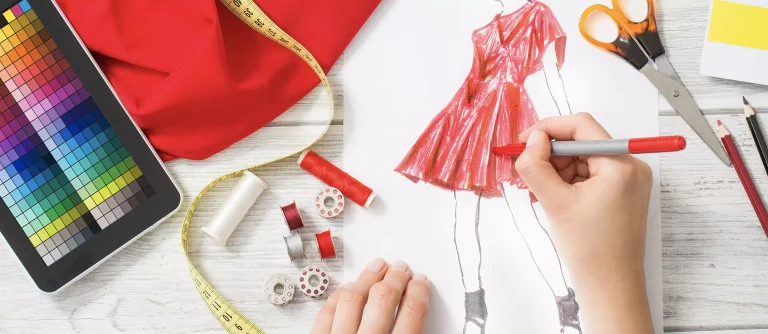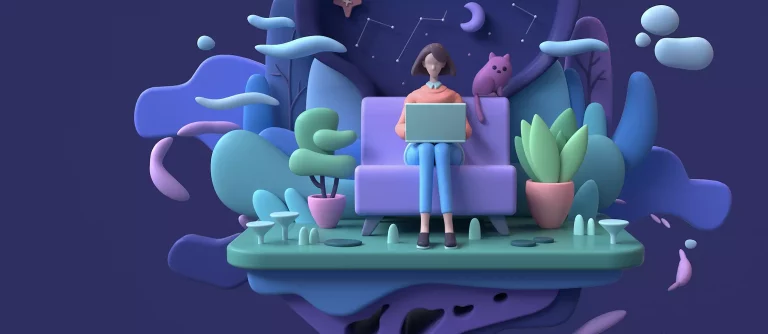How To Become a Videogame Designer
So you’re considering a career as a videogame designer. Perhaps you’re a videogame fanatic and can’t imagine a better job than creating something you love to do. Or maybe you’re passionate about design or coding, and you think creating video games is the perfect way to marry your technical and creative skills.
Whatever the reason this field interests you, you probably have lots of questions–like how does one become a videogame designer? What exactly does a videogame designer do, and how much do they make? And, perhaps most importantly, is it the right field for you?
This comprehensive guide on how to become a videogame designer will answer all these questions and more. Our objective is to cover all the relevant information about this career path, such as education, what a typical workday is like, and ways to break into the industry, to help you decide if life as a video game designer is right for you.
What is a Videogame Designer?
If you’re considering this career path, you must understand a videogame designer’s functions to know if it’s something you want to do. So let’s kick off this guide by taking a look at what someone with this title does.
Video game designers play an integral role in creating video games, as they are involved in almost every element. Along with a development team, they see the game from an initial vision to the finished product.
A video game designer’s job typically starts with defining the concept of the video game. They answer questions such as:
- What is the setting?
- What elements exist?
- How do you play the game?
- What story exists?
- What characters are there?
Once all these elements are defined, the designer must develop a plan of action to build the game. The plan has to fall within specific parameters, which are generally budget and timeframe. The rest of the team, including artists, programmers, and a design team, collaborates to complete the game.
Some specific video game designer duties may include:
- Pitching ideas for new games to management
- Testing their designs and overseeing beta testing sessions
- Developing concepts for games
- Creating storyboards to draw or write their ideas
- Collaborating with marketing teams to create effective advertising for new games
- Choosing themes for new games
What Does a Typical Workday for a Videogame Designer Look like?
What lots of video game designers like about their job is that no two days are the same.
Most companies offer plenty of flexibility to start and end the day when you see fit, though each day typically begins with a team meeting. In this meeting, everyone discusses what was accomplished the previous day, and the goals for that day are laid out. Then everyone goes off to look at emails, plan their workload, and get started.
Depending on where you are in the creation process, a video game designer may do many things. Your day could include writing documentation or putting together game levels. You may have to lay out the game production’s schedule and enforce deadlines, or you could be fleshing out characters.
Besides the typical morning meeting, you may have other meetings throughout the day to firm up various game elements. Sometimes, you’ll have to meet for play-through meetings, which are precisely what they sound like. Team members play recently completed game levels, check for errors, and brainstorm about improving the product.
Will I Like Being a Videogame Designer?
There’s no way to know for sure if you will like being a videogame designer, but this is a great question to ask yourself. What you’re doing right now–research!–is one way to get an idea of how much you might like this career.
We recommend reading this guide from start to finish to help you, but don’t stop there. Take advantage of the information available online to learn more about the profession. Another idea is to speak with actual designers from your area or companies that interest you to hear about their experiences.
As you conduct your research, you’ll likely find that a great majority of video game designers are happy with their careers. However, career satisfaction is often dependent upon having the right personality for the job. So how do you know if you’re made for video game design?
Characteristics and Skills of a Good Videogame Designer
First and foremost, a good video game designer must have a passion for video games and lots of experience playing all types of games. Plus, being familiar with different game consoles and having a strong vision of what makes a good game will help you be more innovative in the design process, and therefore more successful in this field.
A good video game designer also has technical knowledge, including basic scripting and programming, computer animation, and software development. Familiarity with multimedia development software, such as Photoshop, Adobe Creative Suite, and Toon Boom Harmony is also helpful.
But aside from these “hard” skills, the following “soft” skills are also vital in the video game design career:
- Strategic thinking
- Communication
- Storytelling and presentation
- Teamwork and collaboration
- Problem-solving
Why You Might Not Like Being a Videogame Designer
A passion for video games, which we mentioned is a requisite for designers, does not necessarily translate to enjoying this line of work. As you’ve hopefully seen by now, video game design involves much more than playing video games all day. If you don’t like programming or have difficulty conveying your ideas, you might not like this profession.
Additionally, video game design is a highly competitive field, and you may have to make sacrifices when you’re starting. It’s common for beginners to take low-paying gigs, and it’s also common for video game designers to supplement their income in the tech industry, especially in the first few years.
Of course, hours can also be long and irregular. If having a set schedule is crucial to you, a career in video game design is probably not for you.
Typical Schooling for a Successful Video Game Designer
Now that you have a better understanding of what a video game designer does and the skills required, let’s look at what kind of schooling is needed. As you’ve probably already guessed, college is one of several paths into this field, and it’s one of the most straightforward ways to advance your career.
Some universities offer dedicated game design and game development degrees, though these programs are not available everywhere. Aspiring video game designers can pursue a degree in a complementary field, such as computer science or computer programming, if your university does not have specific game design degrees.
Years of Schooling
The number of years you study depends entirely on the degree or certification you choose. The good news? There are several options to choose from, ranging from one to four years, or longer if you decide to do a master’s program. Given this range, there’s certainly a choice that will fit your needs.
Degree Type
- Associate’s. Associate’s degrees are two-year programs that expose you to the fundamentals of video game design. You learn things like coding, illustration, design theory, etc. The entry barrier for this type of degree is low since all that’s required is a high school diploma or GED. Having an associate’s degree may not land you your dream job right away, but it should be enough to put you in the game developing world and obtain experience to get the position you want.
- Bachelor’s. Bachelor’s degrees are four-year programs, which allow you to gain a more thorough understanding of the basics of video game design. If you have the time, it’s worth completing a bachelor’s degree, as it helps you stand out and gives you more opportunities to round out your portfolio. A high school diploma is required, as well as some entrance exams, like the SAT or ACT.
- Master’s. If you already have a bachelor’s, a master’s degree can help make you an even more desirable candidate, as you gain skills related to business and management. A master’s is an option for someone who already has some experience in the field and can help you stand out above your competition.
Certifications
A full university degree not your cup of tea? Some universities allow you to skip general education altogether with video game design certificates. These programs are usually one or two years long, and they are dedicated exclusively to game design. If you are sure this career path is right for you, a certification is an excellent way to prepare you for entry-level positions.
Choosing where to get your certification may seem like a less important decision than deciding where to get a bachelor’s degree, but it’s not one to be taken lightly. Getting a video game design certificate represents a significant investment, both in time and money. So how do you know if the program is the right one for you?
While there’s no magic formula, there are some signs that certification may be right for you. Pay attention to programs that have:
- Renowned professors/instructors/mentors, particularly those whose projects you know about
- Alumni working where you want to work
- Talented students
- Satisfied alumni
Of course, even the best program in the world can’t guarantee you success. But taking advantage of the right one can open many doors.
Best Video Game Designer Colleges
Now it’s time to take a look at the best video game designer colleges. Whether you’re looking for a traditional university with a degree in video game design, or you want to go to a dedicated design school, the aim of both is the same. A degree is designed to prepare you for a career in this field.
You’ll learn all the practical skills you need for success, such as 2D and 3D modeling and animation, drawing, scripting, storyboard rendering, and more. You’ll also be able to take advantage of other benefits, like opportunities for networking, internships, and industry contacts.
The best part is that many colleges can help you on your journey–you don’t need to go to Harvard for the best results. Here are some of the top colleges for video game designers, though this list is by no means exhaustive. We recommend doing plenty of research in this area.
In Person
University of Southern California
Price: $30,000 per year (after aid)
The University of Southern California (USC) features an incredible breadth of degree options, giving students the chance to study practically any aspect that interests them. It has programs like Animation and Digital Arts, Game Design, Computer Science (Games), and Interactive Media. And its location in LA gives students an advantage in finding jobs after graduation.
DigiPen Institute of Technology
Price: $48,981 per year
The DigiPen Institute of Technology opened its doors in 1994, and it has become a top design school since then, even receiving support from gaming giant Nintendo. Students can choose between Game Design or Computer Science and Game Design degrees. DigiPen is known for its small class sizes and location near almost one hundred game development studios.
Drexel University
Price: $34,000 per year (after aid)
Drexel University features both undergraduate and graduate Computer Science, Game Design and Production, and Interactive Digital Media programs. Studying at this university grants you access to its unique resources, like audio recording studios and a 3D theatre. Drexel is frequently regarded as one of the best schools for putting technology in its students’ hands, and its alumni have been the recipients of many awards.
Online
CG Spectrum College of Digital Art
Price: Prices depend on the course you choose. They range from $3,000 to $12,000 for a year-long program.
Get your degree in Animation, Visual Effects, or Game Design at this Rookies Certified college. One of its selling points is that students get access to industry mentors in a small class environment.
Full Sail University
Price: $40,000 per year
Full Sail University offers several game-specific degree programs, such as Animation, Mobile Game Design, Game Art, and Game Development. This online program provides tremendous flexibility, though there are on-campus options available as well.
Savannah College of Art and Design
Price: $42,000 per year (after aid)
Savannah College of Art and Design is an attractive option for both undergraduate and graduate-level courses. The college is accredited in Interactive Design and Game Development, and you can take classes online, in-person, and abroad.
Can I Skip College and Teach Myself How to Be a Videogame Designer?
What about becoming a self-taught videogame designer? Is breaking into this field viable without a degree?
Though most video game designers have formal education, some are self-taught. The internet makes it possible to learn practically any skill nowadays, and game development is no exception. If you’re a self-starter, you can learn the basics you need to make games as both a hobby and a career.
While this path is possible, we’re not going to sugarcoat things. Becoming a videogame designer with no degree or formal training requires hard work and commitment. It also means you have to figure out what to study by yourself instead of completing a prescribed program.
Here are some ideas to get you started.
3 Non-Traditional Paths to Become a Videogame Designer
Choose online classes.
Online learning has become mainstream, and you can find everything from courses to videos to tutorials and more. Platforms like Coursera and Udemy are some of the most popular online learning sites, with industry experts giving step-by-step explanations of subject material.
Learn to code.
Having a working knowledge of various coding languages is a prerequisite to being a successful developer. Classes are available through local colleges or online.
Find a community.
As you’re building the skills you need to become a videogame designer, becoming an active member of an online video game community provides lots of benefits. It helps you gain perspective on what gamers like, which is critical, as they will become your future target audience. You can also connect with individuals in the same boat as you, and you may join forces with the people you meet.
But perhaps the most crucial benefit online communities offer is the insight into how to become a designer. It’s not uncommon for members to mention job opportunities within these communities. And, if you actively provide valuable information and are clear about your intentions, people are likely to think of you when job openings pop up.
Which Software Programs Do Video Game Designers Use?
Video game designers use a variety of programs to bring their concepts to life.
Curious to try them out for yourself? While there are too many to list in this article, here are some of the most popular ones. They include both a free and paid version, which makes them excellent for beginners who want to try them risk-free.
Game Maker
Game Maker is one of the most-used game development tools in the industry, and game designers love it because of how easy it is to use. It features a drag-and-drop system that allows for much faster game creation than with coding. Plus, it has all the tools you need to take your idea from a vision to the finished product.
The free option packs plenty of punch for anyone who wants to get their feet wet, though you can upgrade to the Professional or Master Collection for even more tools.
Construct 2
Another popular game creation tool is Construct 2, which is designed to be beginner-friendly. Use it to create 2D games with no coding experience necessary.
Like Game Maker, it has a drag-and-drop interface that will have you publishing your creations to HTML5 before you know it. You can also use it to design games for web browsers like Kongregate and Facebook.
Construct 2 is available in both free and paid versions.
Unreal Engine
Unreal Engine includes a mighty host of integrated tools for designing and building games, with options for coders and non-coders alike. It’s got a pretty high learning curve, but it’s one of the most professional tools out there. You can also use it to create simulations and visualizations, so it’s well worth getting to know this program.
Unreal Engine allows you to export to various platforms, such as mobile devices, game consoles, computers, and more. But what’s perhaps most excellent about Unreal Engine is that it’s completely free to download and use. You only have to pay when you create a successful game with it.
The threshold for “successful” is defined as revenue of $3,000 in three months, which requires you to pay a 5 percent royalty of your earnings.
Stencyl
You don’t have to have any coding experience to get started using Stencyl, as the drag-and-drop interface is intuitive. It does allow you to code within the program if you prefer, and most designers use it to make fast prototypes of their game concepts. Stencyl is mainly geared toward mobile game creation, though you can make games for Windows and Mac too.
Both free and paid versions of Stencyl are available, with varying publishing capabilities.
Unity
Lastly, we have Unity, which is a software program that practically everyone uses. It’s the only one on this list that does require some coding knowledge, but it’s a powerful tool for creating 2D and 3D games for practically any system. Unity has tutorials to help you learn C programming, so anyone interested in learning can do so.
We recommend taking advantage of this program, which has a robust free version that does practically anything you need. Aside from its capabilities, one reason it’s so popular is that you don’t have to pay royalties unless your revenue is high–over $100,000 per year, to be exact. It’s one of the best tools if you want to build a game to profit off of.
What Are the Best Blogs and Influencer Accounts to Follow?
When you’re just starting in the industry–or interested in learning more–joining an online community can be a fantastic resource. Most people in the video game design field are friendly and willing to help, so it’s easy to find support from your peers.
Here are a few blogs and communities you may find useful:
- Gamasutra. At Gamasutra, you can find plenty of opinion pieces about the video game design process. There’s even a useful careers section where you can find job opportunities.
- Extra Credits. Extra Credits explores game design elements with no review or gaming context.
- League of GameMakers. This blog is all about designing tabletop games.
- CG Society. CG Society aims to empower artists through inspiration, education, recruitment, and information.
- The Rookies. This platform helps new digital artists get their foot in the door without having to compete against professionals. If you’re looking for the best place to start, definitely check this one out!
5 Ways to Break into the Video Game Design Industry
Once you’ve finished studying comes the real challenge: breaking into the video game design industry. Having a certification or a degree does not guarantee you will have immediate success–you’ll need to work hard to reach your goals. Here are five ways to get your foot in the door:
- Get Online. To land your dream job, you need to show that you can build good games. Make sure potential employers can easily access examples of your work online with a portfolio website.
Platforms like WordPress, Squarespace, and Wix make it easy to set up a professional-looking site to sell yourself. Post pictures of your prototypes, design notes, concept art, or anything that shows you know what you’re doing. Bonus points if you can make your game play in the browser. And of course, you can also showcase your work on platforms like Instagram.
- Get Social. Networking can play a vital role in helping you secure employment. If you’re not already on LinkedIn, create a profile, and link your portfolio to it. You should also look for LinkedIn groups related to video game design and become active there, and don’t forget in-person events. Game conferences, meetups, etc., are the perfect opportunity to hang out with developers.
- Become an Apprentice. While not a long-term strategy, working for free can provide a valuable experience. Check out game studios near you that might need an intern, even if they don’t have a specific job posted. Many places are open to hiring someone temporarily, part-time, or as an intern to help them finish games. Becoming an apprentice could be your ticket to landing a job in the future.
- Continue Learning. Just because you’ve yet to secure employment doesn’t mean you can’t be learning elsewhere. There’s always something to improve, so seek out ways to make yourself a better applicant. Check out paid tutorials or free YouTube videos to further your goal. You can also enhance hard skills like Adobe Tools, SCRUM master certifications, or programming languages.
- Keep Grinding. The most critical tip to breaking into the video game industry is to keep grinding. More likely than not, you’ll have early failures, but don’t let them set you back. Finding the right job for you will probably take time–sometimes even years–and lots of rejection. Being rejected time and again isn’t fun, but it’s often what’s required to make it. Be persistent, and keep working to better yourself.
FAQ
Let’s finish up this guide with some frequently asked questions about becoming a videogame designer.
How Much Money Do Video Game Designers Typically Make?
A video game designer’s salary depends on several factors, like location, experience level, and the size of your employer. Many entry-level positions start around $50,000 per year, while senior or lead designers can make $100,000 or more.
What Do You Study to Be a Videogame Designer?
There is no one path to becoming a videogame designer, which means you will meet people with all kinds of degrees.
Some have dedicated game design degrees from renowned universities, but the problem with this option is that it’s not available everywhere. If your local college or university doesn’t have a specialized program, you can get relevant experience in other ways. For example, many aspiring designers choose computer science and software engineering degrees.
Is a Video Game Designer a Good Career Choice?
Building video games is an incredibly rewarding career path. It’s fun, and it allows people to live out their passion every day at work. However, it does require a specific skill set and personality type. If you meet this criteria, video game design could be an excellent career choice.
Some questions to ask yourself are if you:
- Like playing games
- Are creative
- Have strong attention to detail
- Know what makes a game good or bad
- Can handle stress
- Communicate well
- Like programming/computer science
If you identify with all these traits, you may enjoy success as a video game designer.
Are There a Lot of Job Openings for Video Game Designers?
The good news is that video games represent a vital part of an ever-growing industry. The bad news is that, as in any creative field, the competition is stiff. If you want to work for a big name, you’ll need to work hard. You’ll find yourself up against lots of competitors, and getting the job you want may take a while.
What’s the Best Website to Find Video Game Designer Job Listings?
If you’re already interested in a specific company, the best way to find out if they’re hiring is to visit the career page of their website. But this tactic likely won’t produce immediate results, so you’ll need to explore other options for finding work. Luckily, there are plenty of game-industry specific websites with job listings. Here are the best ones:
What Are Some Big Companies That Hire Video Game Designers?
The sky’s the limit when it comes to working for big companies as a videogame designer. Huge names like Nintendo, EA, Epic Games, and Ninja Theory (to name just a few) are always on the lookout for new talent, so don’t be afraid to dream big.







